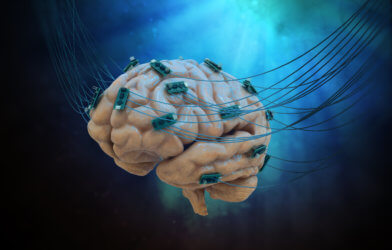Doctor and professor Eduardo Fernández from the University of Miguel Hernández in Elche, Spain created a new device with the help of his team, which he describes as a grid of electronic sensors that produce basic eyesight. The device consists of 100 microscopic needles capable of activating brain cells via electrical signals. The signals are sent from the electrodes to the visual processing center of the brain. Glasses with a built-in camera and a virtual operating system allow the wearer to send visual information from the glasses to the device, during which the information is interpreted by the brain.
For the trial, the team selected a 58-year-old woman who had completely lost her eyesight 16 years earlier. As an educator of science, she was thrilled to be the first to test the device.
To begin, the microneedle array was inserted into her occipital lobe known as the visual processing center. After putting on the glasses, the device activated cells in the area to emit ‘phosphenes’ or white spots of light which were then combined in the form of the picture she was viewing. The device worked to gather the data from the glasses, and then activate cells of the visual cortex to put together the image.
She experienced no difficulties after the procedure. Experts confirmed that the device did not damage or adversely influence her cognitive abilities in any way whatsoever. Furthermore, the device enabled her to recognize various shapes and distinguish basic letters. To help her train her eyesight with the device, a computer game featuring a member of The Simpsons was specifically designed. Because of her very important role, she is a corresponding author of the study, which is also a testament to her knowledge.
“These results are very exciting because they demonstrate both safety and efficacy and could help to achieve a long-held dream of many scientists, which is the transfer information from the outside world directly to the visual cortex of blind individuals, thereby restoring a rudimentary form of sight,” said Prof. Eduardo Fernández.
“This new study provides proof-of-principle and demonstrates that our previous findings in monkey experiments can be translated to humans,” said Prof. P. Roelfsema, a co-author on the study. “This work is likely to become a milestone for the development of new technologies that could transform the treatment of blindness”.
“Although these preliminary results are very encouraging, we should be aware that there are still a number of important unanswered questions and that many problems have to be solved before a cortical visual prosthesis can be considered a viable clinical therapy,” added Prof. Fernández.
“One goal of this research is to give a blind person more mobility,” said Prof. R. A. Normann, also a co-author on the study. “It could allow them to identify a person, doorways, or cars. It could increase independence and safety. That’s what we’re working toward.”
Ideally, the following round of tests will include a more advanced technology by which to decipher the image, which will be able to activate many electrodes at the same time and generate more sophisticated visualizations.
This study is published in The Journal of Clinical Investigation.













Comments